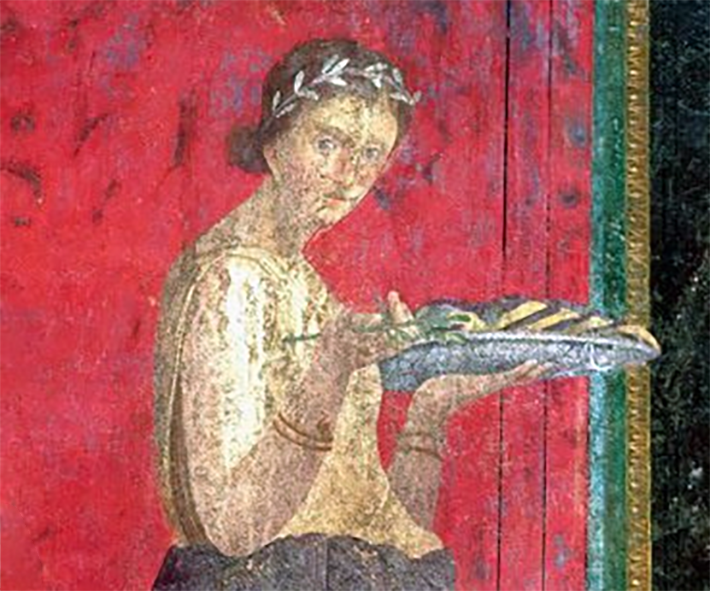
 Click on the image, above to submit to Pinterest.
Click on the image, above to submit to Pinterest.
Isicia de Thursione (A Dry Dish Made with Porpoise Forcemeat)
Isicia de Thursione (A Dry Dish Made with Porpoise Forcemeat) is a traditional Ancient Roman recipe for a dish of simmered porpoise (pork belly) meatballs served with an egg-thickened sauce. The full recipe is presented here and I hope you enjoy this classic Ancient Roman version of: A Dry Dish Made with Porpoise Forcemeat (Isicia de Thursione).
prep time
20 minutes
cook time
30 minutes
Total Time:
50 minutes
Serves:
4
Rating: 
Tags : Pork RecipesAncient Roman Recipes
Original Recipe
The Roman word thursion is typically interpreted as derived from the Greek, which is cognate with
Porcus marinus, literally the 'sea swine'. In Ancient Greek this is typically translated as 'porpoise' (a dolphin). I've avoided this recipe for a while due to the problem of what to substitute for porpoise in the recipe. However, after working on a few medieval recipes (where porpoise is classified as a fish, and so is suitable for eating on non-meat days) I've plumped for a fatty cut of pork; the pork belly as my substitute as this will approximate the texture and fattiness of dolphin (though not the flavour). If you need to use a fish, I would use the tail end of farmed salmon.
Patellam isiciatam: isicia de thursione: enervabis, concides minutatim. teres piper, ligusticum, origanum, petroselinum, coriandrum, cuminum, rutae bacam, mentam siccam, ipsum thursionem. isicia deformabis. vinum, liquamen, oleum. coques. coctum in patellam collocabis. ius in ea facies: piper, ligusticum, satureiam, cepam, vinum, liquamen, oleum. patellam pones ut coquatur. ovis obligabis, piper asparges et inferes.
Translation
A Dry Dish Made with Porpoise Forcemeat: Remove the skin and bones of the fish and chop finely. Pound pepper, lovage, oregano, parsley, coriander, cumin, rue berries, dried mint, and the porpoise [meat]. Shape into meatballs. Put wine, liquamen, and oil [into a pan] and cook. Make the sauce from pepper, lovage, savory, onion, wine, liquamen and olive oil. Put it in a pan and cook. Thicken with eggs [and pour over the meatballs], season with pepper and serve.
Ingredients:
300g boned pork belly
1/2 tsp black peppercorns
2 tbsp lovage
1/2 tsp dried oregano
10g (1/2 bunch) flat-leaf parsley
1/2 tsp cumin seeds
1/4 tsp rue berries
1/2 tsp dried mint
200ml white wine
60ml liquamen (fish sauce)
4 tbsp oil
1/2 tsp black peppercorns
6 tbsp lovage
leaves from 4 sprigs of savoury
1 onion, finely chopped
200ml white wine
1 egg
Method:
Remove the skin (use this for crackling) then chop the belly pork finely. Pound together the herbs and spices in a mortar then add the pork and pound to a paste. Shape this paste into meatballs.
Add the oil, white wine, liquamen and 100ml water into a large pan with a tight-fitting lid. Nestle in the meatballs, bring to a simmer, cover and cook gently for about 20 minutes, until done. Remove from the heat and set aside.
In the meantime, pound together the pepper, lovage, savoury and onion until smooth. Mix in with the wine, then pour into a pan. Bring to a simmer. Crack the egg into a bowl, add a ladleful of the sauce to temper then pour back into the pan with the sauce. Heat gently, mixing constantly, until the sauce has thickened.
Remove the meatballs with a slotted spoon, arrange in a serving dish and pour over the thickened sauce. Garnish with freshly-ground black pepper and serve.

 Click on the image, above to submit to Pinterest.
Click on the image, above to submit to Pinterest.
